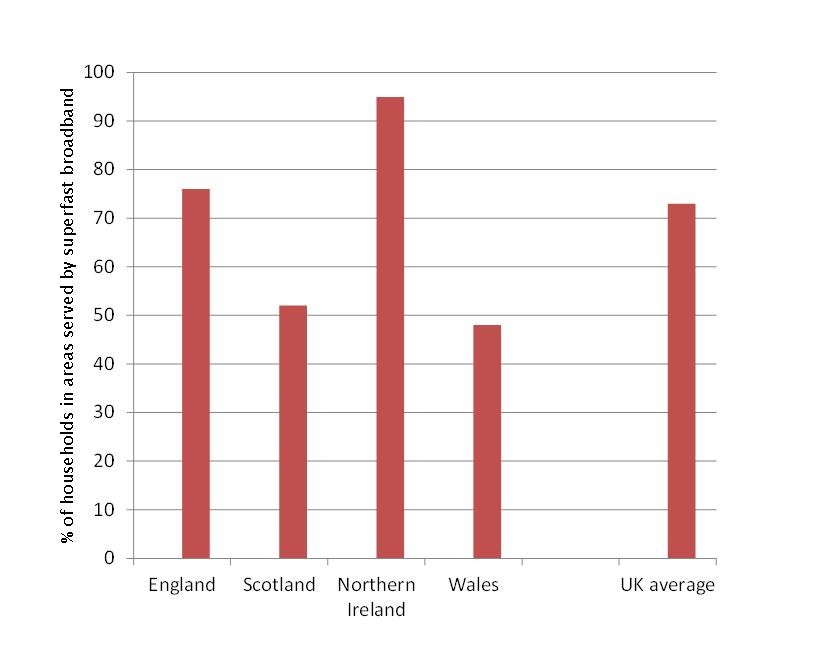Research published last week by Ofcom shows that Wales continues to have the worst access to high-speed internet in the UK. As the graph below shows, 48 per cent of premises in Wales are in areas served by superfast broadband, compared to a UK average of 73 per cent.  By far the best-performing nation is Northern Ireland, where 95 per cent of premises have access to superfast services. And – all going to according to plan – this is where Wales can hope to be in 2016. Northern Ireland’s superior infrastructure is the result of one of the first schemes in the UK to use targeted public funding to roll-out superfast broadband (SFBB) in non-commercially viable areas. A project run by BT from 2009 to 2011 – using funding from the Northern Ireland Executive, the EU and BT’s own investment – led to Northern Ireland having the widest SFBB availability in the UK, despite having the highest proportion of premises in rural areas. BT is currently undertaking a similar project in Wales, known as Superfast Cymru. With a total project budget of £425 million (including £205 million of public funding from the Welsh Government, UK Government and the European Union), Superfast Cymru is intended to roll-out superfast broadband services to 96 per cent of Wales by 2016. Both BT and the Minister for Economy, Science and Transport have assured the Assembly’s Enterprise and Business Committee that so far, things are on track. This would seem to be great news both for individuals – who will be able to access online services regardless of their geographical locations – and the Welsh economy, which could expect to receive a digital dividend from companies exploiting the possibilities of high-speed internet. However, what use is widespread access to superfast services if people don’t subscribe to them? Research has shown that broadband take-up typically mirrors other existing inequalities within society (see section 4.2.3 of Ofcom’s 2013 Communications Market Report). This means that, left unchecked, there is a risk that superfast broadband access could exacerbate existing divisions within society, as better educated people in well-paid professional jobs access superfast services, while more disadvantaged members of society languish in the broadband slow-lane. Furthermore, a number of online services – from online medical support to remote working for rural inhabitants – would seem to be most useful to people currently least likely to have broadband internet at home. In 2012, despite widespread availability, just 11.4 per cent of premises in Northern Ireland subscribed to superfast services. This was the highest take-up rate in the UK. Wales currently has the lowest take-up rate of standard broadband in the UK (66 per cent, compared to a UK average of 75 per cent). These facts beg the question of just how many people will subscribe to superfast broadband services in Wales once they have been made available under the Superfast Cymru project. Significant digital inclusion work by the Welsh Government and BT will be required if Wales is to unlock the potential of superfast broadband.
By far the best-performing nation is Northern Ireland, where 95 per cent of premises have access to superfast services. And – all going to according to plan – this is where Wales can hope to be in 2016. Northern Ireland’s superior infrastructure is the result of one of the first schemes in the UK to use targeted public funding to roll-out superfast broadband (SFBB) in non-commercially viable areas. A project run by BT from 2009 to 2011 – using funding from the Northern Ireland Executive, the EU and BT’s own investment – led to Northern Ireland having the widest SFBB availability in the UK, despite having the highest proportion of premises in rural areas. BT is currently undertaking a similar project in Wales, known as Superfast Cymru. With a total project budget of £425 million (including £205 million of public funding from the Welsh Government, UK Government and the European Union), Superfast Cymru is intended to roll-out superfast broadband services to 96 per cent of Wales by 2016. Both BT and the Minister for Economy, Science and Transport have assured the Assembly’s Enterprise and Business Committee that so far, things are on track. This would seem to be great news both for individuals – who will be able to access online services regardless of their geographical locations – and the Welsh economy, which could expect to receive a digital dividend from companies exploiting the possibilities of high-speed internet. However, what use is widespread access to superfast services if people don’t subscribe to them? Research has shown that broadband take-up typically mirrors other existing inequalities within society (see section 4.2.3 of Ofcom’s 2013 Communications Market Report). This means that, left unchecked, there is a risk that superfast broadband access could exacerbate existing divisions within society, as better educated people in well-paid professional jobs access superfast services, while more disadvantaged members of society languish in the broadband slow-lane. Furthermore, a number of online services – from online medical support to remote working for rural inhabitants – would seem to be most useful to people currently least likely to have broadband internet at home. In 2012, despite widespread availability, just 11.4 per cent of premises in Northern Ireland subscribed to superfast services. This was the highest take-up rate in the UK. Wales currently has the lowest take-up rate of standard broadband in the UK (66 per cent, compared to a UK average of 75 per cent). These facts beg the question of just how many people will subscribe to superfast broadband services in Wales once they have been made available under the Superfast Cymru project. Significant digital inclusion work by the Welsh Government and BT will be required if Wales is to unlock the potential of superfast broadband.



Closing the digital divide
Published 08/08/2013 | Last Updated 27/05/2021 | Reading Time minutes




